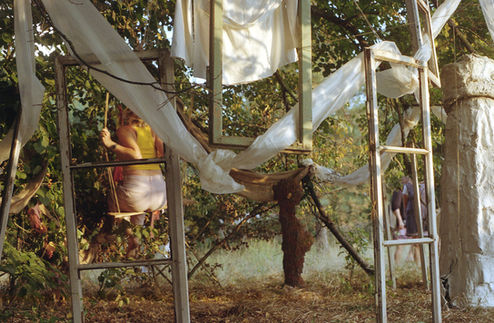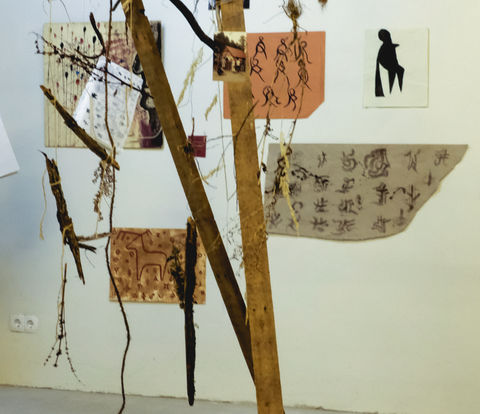
SUMMER SCHOOL 2019
SPIRITUAL
EXPERIMENT
& ART
IN PRACTICE
Led by the experienced artists, along with a broader team of young creatives, everyone lived and worked alongside one another, dropping off one’s own identity and cultural background as an experiential experiment of a temporary tribe. Induced by the collectively created scenario and the gradual chipping away of day-to-day life, everyone was able to indulge in the neo-tribal experience, isolating the human component of themselves as individuals, coming closer to a common ’culture’.
The 2019 edition of the summer school was the first of its kind since 2006. For ten days, workshops, lectures, excursions to nearby Slavonice and Museum Humanum in Fratres, and an evening program were offered in order to support participants in realising their ideas and creating a shared mindset in the communal living.
WORKSHOPS
Each of the five workshops consisted in a one day programme including a lecture or introduction and two parts: one led by the experienced artist of the elder generation and the other led by two younger team members which accompanied the participants throughout the whole process during the summer school. Through the workshops participants could learn easy techniques and get in touch with new materials in order to find inspirations and practices for their own work.
TEXTILE
The textile workshop was lead by Zuzana Krajčovičová twith Alesya Yakubouskaya and Františka Malasková. It was designed with a focus on using materials in alternative ways. Participants worked with various collected materials and then went through a series of exercises to help develop the visual language of communication, as well as to inspire further creation through the different uses of material.

CERAMICS
The ceramics workshop was lead by Romana Krejčí and Julian Boháč. It provided a basic understanding of the whole process of ceramics - from clay to the final product. First it was worked with clay under supervision of Romana Krejčí, who has been working in the field for more than 20 years. The task was to create a bowl, which then was burned in the oven. Afterwards they could be painted and then got burned again.

SCULPTURE
The sculpture workshop was lead by Martin Ceplecha together with Nicolas Prokop and Jan Vagaday. The first part was a visit and tour through Martin Ceplecha's sculpture garden and his workshop in Maříž. The second part consisted in a collective assemblage of found natural objects, creating a large scale installation at Maringotka - the communal space and center of the village. Practices and techniques were then taught individually after request.

The painting workshop was lead by Gisela Prokop-Maczky together with Nima Emami and Ana Pireva. It included a lecture about symbols and natural pigments connected to a practical part in which paints were created from earth pigments in order to create ones own symbol later on. The second part focussed on calligraphic techniques and 5 minute drawing exercises.
PAINTING

PHOTOGRAPHY
The photography workshop was lead by Gabriela Fárová together with Aaron Maar and Jack Laing Aiken. It consisted in three smaller workshops: panorama photography, the cyanotype technique and a composition exercise. Within a one-on-one workshop on panoramas, the participant directed the scene, with the assistance of a teacher. By using an alternative aspect ratio, which people are not used to seeing in, the students really had to consider how they would fill the frame, and the relation between elements within the frame. Inspired by the visual story-telling mechanisms of tribes or cultures who do not have written language, the cyanotype workshop focussed on the 19th century photo-process of cyanotype printing. Each person prepared some textiles to make them light sensiti- ve, and then arranged objects which communicated their characters backstory before leaving the arran- gements in the sun to get exposed. The composition workshop was about composing a scene by re-arranging objects in an individually chosen location and discussing these scenes to start understanding how different people see.

PARTICIPANTS &
SURROUNDINGS


CEREMONIAL WALK
The final outcome of the summer school resembled a ceremonial walk. Starting out from a small exhibition in the barn, where most workshops took place, then guiding the visitors through Maříž and its surroundings. Everyone was asked to create their own site specific installation and possibly a costume, coming together as a small performance of the emerged character, partially based on one’s own archetypal characteristics. The ceremonial walk connected all of the stations shown on on the map above.
Composed of three A2 and eight A3 posters printed on both sides and folded to A4 collected in a slipcase with handmade, unique linocut prints on the cover.
Published in 2019 in an edition of 50, designed by Isabell Alexandra M. and edited in collaboration with Jack Laing Aiken.
EXHIBITION
AT TORHAUS WEHLEN
Gathering and display of objects created during the summer school like artefacts of the temporary tribe, documentary material, like video and photos, and the publication with a guided tour by Philip Chemayel and Gabriela Sojková added up with performances by Alesya Yakubouskaya, Ester Grohová, and Alois Yang.
8. -10.11.2019

The entire project was supported by










































